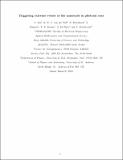Triggering extreme events at the nanoscale in photonic seas
View/
Date
04/2015Author
Grant ID
EP/I004602/1
EP/J01771X/1
EP/J004200/1
Metadata
Show full item recordAbstract
Hurricanes, tsunamis, rogue waves and tornadoes are rare natural phenomena that embed an exceptionally large amount of energy, which appears and quickly disappears in a probabilistic fashion. This makes them difficult to predict and hard to generate on demand. Here we demonstrate that we can trigger the onset of rare events akin to rogue waves controllably, and systematically use their generation to break the diffraction limit of light propagation. We illustrate this phenomenon in the case of a random field, where energy oscillates among incoherent degrees of freedom. Despite the low energy carried by each wave, we illustrate how to control a mechanism of spontaneous synchronization, which constructively builds up the spectral energy available in the whole bandwidth of the field into giant structures, whose statistics is predictable. The larger the frequency bandwidth of the random field, the larger the amplitude of rare events that are built up by this mechanism. Our system is composed of an integrated optical resonator, realized on a photonic crystal chip. Through near-field imaging experiments, we record confined rogue waves characterized by a spatial localization of 206 nm and with an ultrashort duration of 163 fs at a wavelength of 1.55 μm. Such localized energy patterns are formed in a deterministic dielectric structure that does not require nonlinear properties.
Citation
Liu , C , van der Wel , R E C , Rotenberg , N , Kuipers , L , Krauss , T F , Di Falco , A & Fratalocchi , A 2015 , ' Triggering extreme events at the nanoscale in photonic seas ' , Nature Physics , vol. 11 , no. 4 , pp. 358-363 . https://doi.org/10.1038/nphys3263
Publication
Nature Physics
Status
Peer reviewed
ISSN
1745-2473Type
Journal article
Description
This work is supported by Kaust (Award No. CRG-1-2012-FRA-005), by NanoNextNL of the Dutch ministry EL&I and 130 partners and by the EU FET project ‘SPANGL4Q’.Collections
Items in the St Andrews Research Repository are protected by copyright, with all rights reserved, unless otherwise indicated.

